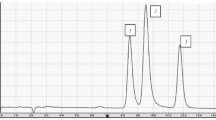Abstract
Single oral and intramuscular (i.m.) doses of imipramine (IMI) were administered to four normal males. Serum and urine concentrations of IMI, desipramine (DMI) and their unconjugated 2-hydroxy metabolites were measured by high-pressure liquid chromatography (HPLC). Urinary conjugated 2-hydroxy metabolites were also measured after enzyme hydrolysis. Computer analysis of serum concentration and urinary excretion rate data allowed confirmation of drug and metabolite kinetics, and calculation of pharmacokinetic parameters. The rapid appearance of the metabolites in serum indicates that sequential firstpass metabolism of IMI involves both hydroxylation and demethylation. However, the dose-normalized areas under the serum concentration-time curves indicate that the fractions of the doses converted to metabolites were similar after both routes of IMI administration. Similar total fractions of the i.m. and oral doses recovered in urine indicate complete absorption of the oral doses. Inclusion of the metabolites increased the apparent availability of active components after oral IMI from 22%–50% to 45%–94%. Both the 2-hydroxy metabolites exhibited formation rate-limited kinetics, whereas DMI kinetics were elimination rate-limited. The t 1/2 of IMI and 2-hydroxyimipramine (2-OH-IMI) was 6–18 h, while that of DMI and 2-hydroxydesipramine (2-OH-DMI) was 12–36 h. The t 1/2 of these compounds was 1.5–2 times longer after the i.m. doses. The metabolite/parent ratios and the disposition of the individual metabolites confirm findings that chronic dosing results in only limited accumulation of hydroxy metabolites.
Similar content being viewed by others
References
Bjerre M, Gram LF, Kragh-Sorensen P, Kristensen CB, Pedersen OL, Moller M, Thayssen P (1981) Dose-dependent kinetics of imipramine in elderly patients. Psychopharmacology 75:354–357
Borga O, Piafsky KM, Nilsen OG (1977) Plasma protein binding of basic drugs I. Selective displacement from α1-acid glycoprotein by tris (2-butoxyethyl) phosphate. Clin Pharmacol Ther 22:539–544
Brodie BB, Bickel MH, Sulser F (1961a) Desmethylimipramine, a new type of antidepressant drug. Med Exp 5:454–458
Brodie B, Dick P, Kielholz P, Poldinger W, Theobald W (1961b) Preliminary pharmacological and clinical results with desmethylimipramine (DMI) 635020, a metabolite of imipramine. Psychopharmacologia 2:467–474
DeVane CL, Jusko WJ (1981) Plasma concentration monitoring of hydroxylated metabolites of imipramine and desipramine. Drug Intell Clin Pharmacol 15:263–266
DeVane CL, Savett M, Jusko WJ (1981) Desipramine and 2-hedroxydesipramine pharmacokinetics in normal volunteers. Eur J Clin Pharmacol 19:61–64
Gibaldi M, Perrier D (1975) Route of administration and drug disposition. In: Swarbrick J (ed) Pharmacokinetics. Marcel Dekker, New York; pp 229–252
Gillette JR, Dingell JV, Sulser F, Kuntzman R, Brodie BB (1961) Isolation from rat brain of a metabolic product, desmethylimipramine, that mediates the antidepressant activity of imipramine (Tofranil). Experientia 17:417–418
Gram LF, Christiansen J (1975) First-pass metabolism of imipramine in man. Clin Pharmacol Ther 17:555–563
Gram LF, Fredricson-Overo K (1975) First-pass metabolism of nortriptyline in man. Clin Pharmacol Ther 18:305–314
Gram LF, Andreasen PB, Overo KF, Christiansen J (1976) Comparison of single dose kinetics of imipramine, nortriptyline and antipyrine in man. Psychopharmacology 50:21–27
Heikkila RE, Goldfinger SS, Orlansky H (1976) The effect of various phenothiazines and tricyclic antidepressants on the accumulation and release of (3H) 5-hydroxytryptamine in slices of rat occipital cortex. Res Commun Chem Pathol Pharmacol 13:237–250
Jandhyala BS, Steenberg ML, Rerel JM, Manian AA, Buckley JP (1977) Effects of several antidepressants on the hemodynamics and myocardial contractility of the anesthetized dogs. Eur J Pharmacol 42:403–410
Lehman JP, Fenselau C, Depaulo JR (1983) Quaternary ammonium-linked glucuronides of amitriptyline, imipramine, and chlorpromazine. Drug Metab Dispos 11:221–225
Metzler CM, Elfring GL, McEwen AJ (1974) A package of computer programs for pharmacokinetic modeling. Biometrics 30:562
Nagy A, Johansson R (1975) Plasma levels of imipramine and desipramine in man after different routes of administration. Naunyn-Schmiedeberg's Arch Pharmacol 290:145–160
Nagy A, Johansson R (1977) The demethylation of imipramine and clomipramine as apparent from their plasma kinetics. Psychopharmacology 54:125–131
Nies AS, Shand DG, Wilkinson GR (1976) Altered hepatic blood flow and drug disposition. Clin Pharmacokinet 1:135–155
Potter WZ, Calil HM, Manian AA, Zavadil AP, Goodwin FK (1979) Hydroxylated metabolites of tricyclic antidepressants: preclinical assessment of activity. Biol Psychol 14:601–613
Potter WZ, Calil HM, Zavadil AP, Jusko WJ, Sutfin T, Rapoport JL, Goodwin FK (1980) Steady-state concentrations of hydroxylated metabolites of tricyclic antidepressants in patients: relationship to clinical effect. Psychopharmacol Bull 16:32–34
Potter WZ, Calil HM, Sutfin TA, Zavadil AP, Jusko WJ, Rapoport J, Goodwin FK (1982) Active metabolites of imipramine and desipramine in man. Clin Pharmacol Ther 31:393–401
Sutfin TA, Jusko WJ (1979) High-performance liquid chromatographic assay for imipramine, desipramine, and their 2-hydroxylated metabolites. J. Pharmaceut Sci 68:703–705
Veith RC, Raisys VA, Perera C (1978) The clinical impact of blood collection methods on tricyclic antidepressants as measured by GC/MS-SIM. Commun Psychopharmacol 2:491–494
Walle T, Fagan TC, Conradi EC, Walle UK, Gaffney TE (1979) Presystemic and systemic glucuronidation of propranolol. Clin Pharmacol Ther 26:167–172
Walle T, Conradi EC, Walle UK, Fagan TC, Gaffney TE (1980) 4-Hydroxypropranolol and its glucuronide after single and long-term doses of propranolol. Clin Pharmacol Ther 27:22–31
Yamaoka K, Nakagawa T, Uno T (1978) Statistical moments in pharmacokinetics. J Pharmacokinet Biopharm 6:547–558
Yeh KC, Kwan KC (1978) A comparison of numerical integrating algorithms by trapezoidal, Lagrange, and spline approximation. J Pharmacokinet Biopharm 6:79–97
Author information
Authors and Affiliations
Rights and permissions
About this article
Cite this article
Sutfin, T.A., DeVane, C.L. & Jusko, W.J. The analysis and disposition of imipramine and its active metabolites in man. Psychopharmacology 82, 310–317 (1984). https://doi.org/10.1007/BF00427676
Received:
Accepted:
Issue Date:
DOI: https://doi.org/10.1007/BF00427676




